Feels like this is a moment of Weaponized Nostalgia, at least as far as mainstream television programming is going. This past week saw the launch of the new Night Court sequel/series as well as the similar That ‘90s Show, while we’re awaiting the return of Quantum Leap and for the new season of How I Met Your Father to drop. And so forth. And this is nothing new, we’ve been seeing this trend in popular entertainment all over the place for quite some time now. It’s way easier to get people to jump on board and try out a series (or film, or comic, or whatever) if it’s something that they’re already predisposed to have an attachment to. Fortunately, there’s still enough new stuff coming out where the cries from certain corners about how uninspired all of this rehashing is can’t quite gain traction. But it does point to the fact that there’s an easy shortcut in storytelling that a lot of different people are all using all at once. But these new shows are only going to last if they’ve got more going for them than just a rehash of older, earlier material. If they don’t, if they’re badly written, badly put together and just generally shabby, then they’re…well, they’re STAR TREK: PICARD. And even there, drop enough Weaponized Nostalgia on the scale all at once (“Look—the whole original NEXT GEN cast is coming back!”) and even people who are well aware of what an absolute train wreck the previous two seasons have been won’t help themselves but to get excited. And hell, I’m going to wind up watching it, so I’m no exception to this rule. It does all speak to an overall search for comfort food, maybe because everybody’s still dealing with an ongoing Covid situation and a depressed economy as a result of it. As a few of these things find some success, I expect to see a bunch more releases in this vein in the next couple of years.
Moving on into the question and answer portion of the program, we start out this week with a communication from Stephen Wacker, former Marvel editor who is now plying his trade over at Jonathan Hickman’s 3W3M among other places. Steve wrote in to give us some additional details on that unused AMAZING SPIDER-MAN cover I showed a few weeks back:
Late to the party here, but that Spidey "cover" was for a feature we did in ASM #600 called "Spider-Man Covers You'll Never See" that was a nod to the classic "What If...?" #34
I know Bendis and Loeb each contributed a gag as well, but I can't recall who came up with this one in particular. However, McKone drew the hell out of it. (I generally hated being drawn into books, but I've never looked better!)
While it was intended as a Bugs Bunny/Elmer Fudd style gag, Gay Marriage became a hot button political issue in the midst of putting the comic together. So there was a reasonable fear it would look like we were making fun of something that actually mattered or making some kind of obscure statement. The page was therefore spiked (which makes sense in hindsight, though I was bummed at the time since it's so funny.)
Also I have every issue of Comet Man! Marvel TV was sick of hearing me pitch it as a TV series a few years back.
Steve isn’t kidding here, he was a big fan and reader throughout the 1980s when COMET MAN was first published and I have no doubt that he did pitch it as a show at every opportunity.
Next up, Kent L. wrote to give us this update on that awesome comic shop in Ohio that I showed off photos from last time:
RE Up Up and Away!: Pretty sure that location is still around. The one you went to is in Blue Ash, OH, a suburb of Cincinnati. It really is amazing (or was--I haven't been there in a while, either). Definitely one of my favorites. Planning a trip up there in May, so maybe I'll swing by again. https://goo.gl/maps/mGkXkaXLEQQ2LQLG9
Appreciate that, Kent! And if anybody is going to be in the area, it genuinely is worth stopping off at.
Getting into the real questions now, Mark Abnett wondered:
Hi Tom! Has Marvel every attempted to create a map of their multiverse much in the same way as Grant Morrisons Multiversity Map?
I gave it a crack a few years ago but there’s probably a better way of putting one together https://images.app.goo.gl/jEY3SuYUxvECSmNn9
You mean, like a map that attempted to put them all into relative space with one another? I don’t know that, by and large, our Multiverse really needs that much guidance, as almost all Alternate Realities are the product of branching timelines as some key choice or decision was made differently. In that way, the Marvel Omniverse looks like a tree, with more and more branches the further “up” it you go. It’s possible that the Handbook researchers have done something like that, but I’m not aware of any official version.
Jason Holtzman asks:
That being said, If you feel inclined to share, is there a particular superhero casting you feel is one-of-a-kind? Any performance that is going to be hard for audiences to believe in a replacement for later down the line? That being said, it feels like there are always castings people don’t believe in who quickly change their tune after actually seeing it.
And/or, on the other hand, is there a dream casting you have for a comic book character on the screen? Perhaps you’ve got your eye on a character you want to play🤷🏻♂️
I think there have been actors who have been remarkably well cast as the characters they play, Jason—Chris Evans as Captain America, for example. But given that these characters are all apt to live on long enough where recasting will ultimately be done (and in the cases of the DC characters particularly, has already happened a few times) I don’t know that anybody’s performance can necessarily be considered one-of-a-kind. Maybe I’m taking that phrase too literally, but that’s just the way I am. But for example, I think just about everybody would agree that Christopher Reeve embodied Superman to perfection on the big screen, even when the films he was starring in weren’t all that wonderful. But that hasn’t stopped all sorts of people over the last decade from loving Henry Cavill in that role, and wanting to see him restored to it again (most loudly of all, my otherwise sane and reasonable mother.). None of that takes away from Reeve, it’s a generational thing as much as anything else. But I don’t know that there can ever be a Spider-Man who’s so note-perfect that nobody who comes after him will be able to find anything new to do with the role.
And nobody wants to see me play any of these characters, or really to appear at all. Not only do I have no particular skills or training in this area, but I’m also not especially wonderful to look at.
Anthony questioned:
Hi Tom, I’m curious about the current ASM and FF runs, specifically starting new volumes with the very similar premise of “something big/bad happened 6 months ago, we’re going to drop you in medias res after a time jump and a status quo shaek-up, then slowly explain what happened over the course of the run”. Both books are great and as they came from different editorial teams my assumption was that this one of those coincidences that seem to happen all the time in art (an A Bug’s Life/Antz, or more appropriately Swamp Thing/Man-Thing situation), is this accurate? Were there conversations between the editorial teams after this became apparent? As FF #1 came out later, was there any consideration of making changes or was it too late in the piece/not worth changing?
When you’re working on so many different series in a world that’s full of so many more comics and even more films and television shows and books and etc, it’s inevitable that there are going to be duplicated ideas or themes from time to time. In the case of AMAZING SPIDER-MAN and FANTASTIC FOUR, to be honest any similarity really didn’t concern me, because it’s only the most basic surface similarity. Once you get into the specifics, these are pretty clearly two different situations. And nobody on the Spidey editorial crew brought up any reservations or objections when I laid out what we were planning to do. In part, that may be because the core nugget of the story in FANTASTIC FOUR is something that I’ve had in my back pocket for twenty years now, and which was invented with Mark Waid back when he was writing the series, and never used. Maybe I’ll tell you about it once the reveal issues of FF come out and we can speak more specifically.
Next, one from Jamiejames:
Here's half a question: Fantastic Force!
Issues 1, 8 & 9 are now on Marvel Unlimited, so you're now about to be rich, right? That's how M.U. works, I assume. How'd you end up writing those bad boys (and girl) and how soon can we expect a Disney Plus show about them?
I feel like a walkthrough on FANTASTIC FORCE is going to take a bit more space than we have here, so let me save that for a later time when the book comes up naturally in our Books I Worked On feature. But the short answer is that another creative team entirely was supposed to be launching it, they reached irreconcilable differences with the editor and quit, the book was seriously late and I had just done a FANTASTIC FOUR UNLIMITED story that had turned out decently (though it didn’t see print until after FANTASTIC FORCE had launched, so late was it running.) Oh, and as a staff member of Marvel, I don’t receive any additional income when any of my previous writing work is reprinted. That’s one of the ground rules.
Y. Lu wondered:
My question this time’s on multiple characters sharing the same superhero name, a trend that’s risen over recent decades. It feels to me that Marvel used to have an inclination against this sort of thing. When two characters had the same name, the typical route seemed to be to actually rename one of them, like with Monica Rambeau becoming Photon.
Was this an actual policy, on some level, at Marvel back then? And whether policy or just general inclination, what would you attribute the change in attitude to?
Policy is maybe a little bit strong of a word, Y., but it was definitely a preference so as to help avoid confusion. It’s the reason why Richard Rider was known as Kid Nova for his first year back in NEW WARRIORS, for example, even though that was a pretty stupid and unnecessary change. And I think what changed it was both a change in the marketplace—DC has been fielding multiple versions of characters with some of their most classic names—Robin, Flash, Green Lantern, etc—for many years. And additionally, there started to be more and more instances where you didn’t want to change a character’s name and in doing so appear to be demoting him. The prime example of this is probably Miles Morales once he came over to the mainstream Marvel Universe. In the Ultimate Universe, it was easy for him to be Spider-Man, but that was more of a problem in a world where Peter Parker was still alive and active and not going anywhere. And yet, giving Miles a different name felt like demoting him to “Spider-Boy” or some such, in a way that would do some lasting damage. There was a lot of back-and-forth conversation on this point over the years, and a couple of moments where Miles was poised to get a new super hero name. He’s also been known by a few other names in animation and on toys, which was the result of either consumers or else the toy buyers being worried that having multiple Spider-Mans would cause their customers confusion. I still don’t really think it’s a great idea to have multiple main characters with the same name. And yet, by that same token, given that Sam Wilson is going to be Captain America for who-knows-how-long in films and on television, and yet we don’t have the same difficulties in keeping the Steve Rogers version of Cap continuing on in the books, I don’t know that there’s going to be any permanent way of getting rid of it any time soon.
Finally, Jeff Ryan wanted to know:
Q for you! This Onslaught issue of Spider-Man https://marvel.fandom.com/wiki/Spider-Man_Vol_1_72?file=Spider-Man_Vol_1_72.jpg has a "This Month's Marvel MUST-READ button on it. What's the history of that? Was there truly only one a month? Who decided which issue got it? How long did it last?
You know, this question has come up before over the years, and I really have to hand it to Bob Harras on this. No, Jeff, this wasn’t anything other that a bit of one-time cover copy that Bob had suggested to ASM editor Ralph Macchio in Stan Lee hyperbolic style to help promote that particular issue. There was no judging panel, no committee who weighted the importance and quality of every title we were releasing that month and who awarded the badge on excellence in 25 distinct categories. It happened once, on the cover that you pointed to. That said, having seen how easy it is to get readers to buy into it as a mark of importance, maybe I ought to try bringing it back on some upcoming cover to see if it will spike sales.
Behind the Curtain
.I spoke about this last week, but now I’ve gone ahead and dug up the document in question. This is a memo circulated by then-Marvel President Bill Jemas to key editors and creators talking about the possibility of “Ultimate-izing” the whole Marvel publishing line:
This memo was sent out right near the end of Bill’s tenure in that job, so as far as I know, nothing more ever really happened with it. I would guess that a few of the people on that distribution list had conversations with him about it, notably Joe Quesada, Brian Bendis and Mark Millar. But there was never any organized meeting or discussion—the balloon was simply floated and then never followed up on. I’m guessing that’s because Bill was having more immediate things to worry about in that moment. But this was all an outgrowth of Bill’s growing disenchantment with the established Marvel Universe and his feelings of invincibility in the success of the Ultimate Universe—for all that Bill presents this situation in reasonable terms in this document, whenever it came up in casual conversation, his clear affection was for the Ultimate Universe. But it doesn’t really matter, as nothing of this sort ever really happened, at least not at that moment.
Pimp My Wednesday
Another very small week for a change, with only one new comic coming your way from us this Wednesday:
ALL-OUT AVENGERS #5 wraps up the initial iteration of this series and sets the stage for its next evolution as AVENGERS BEYOND in a month or two. As before, the issue is written by Derek Landy and drawn by Greg Land, both of whom had a whole lot of fun with this month’s special guest star, the Amazing Spider-Man. As usual, it’s fast-paced and kinetic, and it turns over a big card in terms of what’s been going on over the past five months. If only I had thought to put a “This Month’s MUST READ Marvel Comic” button on the cover!
A Comic Book On Sale 80 Years Ago Today, January 22, 1943
Not really a full write-up on this one, just a quick shout out to this eight-decade-old issue of ADVENTURE COMICS because its cover by Joe Simon and Jack Kirby is just so clever and so much fun. When Simon & Kirby were lured over to DC/National Comics following the enormous success of CAPTAIN AMERICA at Timely, they didn’t have a series to work on yet—they had been developing a sort of Super Sherlock Holmes concept, but the publisher apparently didn’t like it. So instead, while the pair found their feet, they were given a few existing strips in ADVENTURE COMICS to revamp in their style. They promptly turned Manhunter into a super hero rather than a non-costumed adventurer, and introduced a recurring motif of dreams into the Sandman, while packing the strips with their own brand of split-second action. Neither of them was quite the breakout hit that DC had been hoping for (though that would come once the team introduced the Boy Commandos over in DETECTIVE COMICS) but they did pick up enough renewed interest that the both were featured in the cover position for several issues, ousting the lackluster Starman from the pisition.
A Comic Book On Sale 20 Years Ago Today, January 22, 2003
There’s really only one book that we can talk about here, and it’s this one.
Robert Kirkman’s INVINCIBLE debuted twenty years ago today on January 22, 2003, and was part of the one-two punch along with THE WALKING DEAD that catapulted him to not just fortune and stardom, but to becoming the only latter day Image creator to become one of the owner/operators of the imprint. At the moment, a second season of the animated INVINCIBLE series is in the offing on Amazon Prime, and the first season was generally well-regarded. But this almost didn’t happen—the book almost wrapped up prematurely after around 8 issues or so. INVINCIBLE was launched as part of a multi-book initiative spearheaded by Image’s then-Publisher Jim Valentino. After a couple of years in branching out to publish all sorts of idiosyncratic and personal works, Valentino saw a need to get back to what the core business of Image had been: alternative creator-owned mainstream super hero properties. Four titles were rolled out, with most people betting on Phil Hester and Andy Kuhn’s FIREBREATHER to be the breakout hit of the bunch. Instead, it wound up being this underrated series. And the reason for the title’s initial sluggish sales also turned out to be the thing that saved it. INVINCIBLE is the story of Mark Grayson, a teenager whose father is secretly Omni-Man, the most powerful super hero on Earth. Mark, it winds up, inherits his dad’s powers—powers that stem from his heritage as a member of the alien Viltrumite race, including super-strength, invulnerability and flight. The opening bunch of issues concern Mark starting his super hero career, selecting a code-name and getting a costume designed and tailored. It was nicely done, but wasn’t really doing anything all that noteworthy. And that’s because Kirkman had left his big series twist for the climax of his first year. You see, the real secret of INVINCIBLE is that Omni-Man, everyone’s favorite super hero, is actually an advance envoy for the Viltrumite Empire who intends to conquer and subjugate the world. It’s a hell of a heel-turn when Omni-Man suddenly turns on his fellow Guardians of the Globe, massacring them all. INVINCIBLE wasn’t afraid of showing ridiculous levels of blood and gore, well beyond what any other mainstream publisher was going to show in a series like this. The first year ends with Mark learning the truth and having to battle his father. He’s no match for his Dad, but in the end, his father can’t bring himself to kill Mark, and so he jets off for parts unknown, leaving Mark to grapple with the ramifications of these revelations. Suddenly, INVINCIBLE was a lot more electric, and was going places that other comics weren’t, and its sales steadily increased to well beyond the point where it would be considered a success. The series ran for 144 issues before Kirkman wrapped up all of his storylines and brought things to a close, one determined by the story and not an arbitrary cancellation. The series reads better in collected edition form, as Kirkman doesn’t do much of any recapping along the way at all. (He also doesn’t use any captions or thought balloons apart from telepathic communication between characters.) Cory Walker was the initial artist on the book, but he wound up pursuing other options after a dozen or so issues (though he’d return to it from time to time). But the bulk of INVINCIBLE was illustrated by Ryan Ottley, who developed a fun, bombastic and energetic style to his work, one that often employed splash pages to good narrative effect. INVINCIBLE was one of the best action-oriented super hero titles available for the duration of its run, and it’s certainly worth seeking out in collected edition now that it’s finished.
A Comic I Worked On That Came Out On This Date
FF #16 first came out on January 22, 2014 and was the final issue in that iteration of the series, a really fun book that came apart just a little bit at the end, thanks to me. This was the sister title to FANTASTIC FOUR, initially launched after the death of the Human Torch when the team started up the Future Foundation, and continuing on as a separate series even once FANTASTIC FOUR had been restored. This was all during Jonathan Hickman’s tenure, but once his time was done, we lined up Matt Fraction to take over both series. Needing a concept that would anchor not just one title but two, Matt came up with the idea that the Fantastic Four proper, along with their kids, would embark on a learning adventure across time and space, one that was only meant to last four minutes back on Earth. Not wanting to leave the Earth undefended even for that short time, the four heroes each recruited what was meant to be a momentary stand-in for them: Ant-Man, She-Hulk, Medusa of the Inhumans, and Ms. Thing, a pop star that Johnny Storm was involved with who would wear the Thing’s old exo-skeleton suit from some old 1970s stories. Of course, this being the Fantastic Four, the four minutes come and go, and there’s no sign of Marvel’s First Family. So this makeshift team of replacements has to fill their shoes—not only as super heroes but also as the instructors for the Future Foundation, which is chock-full of gifted students from a variety of cultures and backgrounds. The thing that really elevated FF was Matt’s idea that we’d offer the series to Mike Allred to illustrate. Mike is a longtime FANTASTIC FOUR fan, and his poppy, energetic style would bring a certain independent energy to the series. This was shortly after Matt and David Aja had made HAWKEYE into an offbeat hit, and so while there might have typically been some resistance to Allred helming a more-or-less central series, at this moment there wasn’t. (It probably helped that the actual FANTASTIC FOUR series would be drawn by stalwart Mark Bagley.) Allred definitely helped to elevate Matt’s game here, and so FF grew to be the better of the two series—there wasn’t anything wrong with Matt’s FANTASTIC FOUR, it was just that FF had a little something extra in the tank, a more unique flavor. But after around a dozen issues of each series, things hit a snag. Matt was still writing IRON MAN at the time, and he had made a pitch to helm Marvel’s plans to expand the mythos of the INHUMANS into their own series and beyond. Something had to give, and that something was FANTASTIC FOUR/FF. As Matt’s schedule started to suffer, I went to a meeting where it became apparent that something had to come off of his workload—and the clearly preferred choice was FANTASTIC FOUR. I dutifully called Matt and broke the news to him, telling him that I had no choice but to take him off the books. But this left me in a bad spot, as both titles were in the middle of a long-running storyline, the resolution to which had only casually been talked over. After attempting to stopgap by having Matt’s friend Chris Sebela co-write with him, I came to the conclusion that I needed to bring in new writers to guide the story to its end. On FANTASTIC FOUR, I called upon my usual problem-solver, Karl Kesel, whose love for the FF was well known. Speaking with Mike about a replacement writer for FF, he suggested his older brother Lee Allred, who had some credentials as a prose author. Together, they all worked to beat out an overview for the final three or four issues of each title in such a way that they would dovetail and things would all come together. And it all sort of worked. Of the two books, FF was still the better, as somehow being liberated from all outside influence gave Mike Allred permission to steer directly into his wildest impulses, with Lee being entirely on the same wavelength. None of it is quite as good as it might have been had Matt been able to end things as originally intended, but the readers at least got a satisfying conclusion. We also added a special bonus feature in both issue #16s—it was a 10 page story featuring the casts of both series, illustrated by Allred and written by Kesel. The trick was that it was actually a 15 page story, with each book having 5 pages in common along with 5 other pages that related more directly to that specific series. So you couldn’t really read and absorb the whole thing without both parts. Also, as we were working on this final issue, Mike mentioned to me his great desire to do a SILVER SURFER series, and I filed that away for almost immediate future use.
Another Comic I Worked On That Came Out On This Date
The UNTOLD TALES OF SPIDER-MAN Trade Paperback first saw print on January 22, 1997, and collected the first eight issues of the series. It also carried a pull-quote from a review on its back cover the printing of which almost got me fired. I’ve already recounted that story at length here, so I’m not going to repeat it again. If you don’t know it already, click the link and you’ll learn all about it, and more.
But since we’re commemorating the 25th anniversary of its publication, let me also go ahead and showcase this original artwork from Pat Olliffe’s new cover, inked as usual by Al Vey. I’m certain that it was writer Kurt Busiek who came up with the concept for the image, Peter developing photographs of Spider-Man’s cast of character that he’s taken, as it was a good way of showing off a number of villains and supporting players and giving buyers a sense of the series. This collection was done at a time when Marvel didn’t really have a regular Trade Paperback program, so it was a really special thing to get a book like this at the time (though I’m certain that I stumped for it. The assorted award nominations the series had picked up didn’t hurt in that regard either.)
Monofocus
Got a diverse assortment of bits to share with you here. First off, I finished off the tenth and final volume of the current Viz reissue of Rumiko Takahashi’s classic strip MAISON IKKOKU. I had read this material before, but not in decades, and so it was all very fresh to me. And it’s a thoroughly satisfying ending. Takahashi’s ability to create situations of misunderstanding and romantic complication had been the backbone of the strip for most of its run, keeping the two lead characters Godai and Kyoko from making much progress in their relationship. But here, at the end, she needs to resolve all of those complications in a natural fashion, and still craft a tender resolution not only for her leads but for the entire cast. And she does so wonderfully. It’s a great strip, probably my favorite of her canon, and I recommend it without reservation.
Also, I’ve spoken here in past weeks about watching the Sentai parody series UNOFFICIAL SENTAI AKIBARANGER, but the final episode of its first season was especially amazing and meta! Having survived a series of odd and ridiculous plot twists and reversals in the prior few episodes, the lead characters come to the conclusion that their reality must be a television series—and that the producers of the show are attempting to bring it to a premature end! Events escalate from there, with the characters attempting to begin new slow-burn plotlines so as to prevent the show from being ended on them. I really thought it was charming and fun, and the whole thing can be watched, subtitled, here. It’s only 23 minutes or so, and is definitely worth your attention.
In another follow up, I’ve now sat through most of the American version of THE TRAITORS, which I liked well enough. Having sampled both the UK and Australian versions before this, I can say with some certainty that the UK incarnation is the best of the three. The American version in particular, as you’d expect it would, devolves rather rapidly into the sort of trashy drama-laden behavior typical of the genre in the States. (No surprise, as I say, given that most of the cast is made up of people who had previously appeared on other reality shows in the U.S.) That said, the biggest problem with all three versions of the show is that the game is set up in such a way that there really isn’t any way that the cast of “Faithful” players can get any genuine clues as to who the “Traitors” among them are. So it’s all just a random crapshoot, as one person after another is accused based on the flimsiest of evidence. In this respect, the similar Korean series BLACK SHEEP GAME was a step up, in that the fact that each player was accorded traits endemic to their pasts and personalities and the “Black Sheep” in that game shared one specific trait between them meant that there were ways during the gameplay to discover and eliminate certain traits, and so legitimately narrow down the field. I don’t know that I’d watch any more of THE TRAITORS regardless of its nation of origin (though I’d definitely tune in to see a version produced in yet another country, just to see how the game changed.)
And finally, a couple of you had recommended the CARTOON KAYFABE YouTube Channel to me when I was lamenting the lack of cogent comic book criticism a few months back, and so I can report that I have been watching a number of its videos. In particular, I’ve been going through the Courtroom installments, in which Ed Piskor and Jim Rudd read through the court testimony of several noteworthy comic book personalities in a number of historic lawsuits. It’s a nice way to absorb that information, and Ed and Jim break the installments down into manageable increments, which helps. I don’t necessarily share their perspective in all situations, of course, but it is fun to watch them try to parse their way through these cases, realizing that in most instances there isn’t a white hat and a black hat, but rather two flawed parties neither of whom is entirely right or wrong.
Posted at TomBrevoort.com
Yesterday, I picked on another (Not So) Great Cover from the past as well as laying out some basic cover theory that’s hopefully worth taking a look at.
And five years ago, I wrote about this issue of SUPERMAN.
Once again, thanks for stopping by, have a good day and a great week and I’ll hopefully see you again in seven days.
Tom B





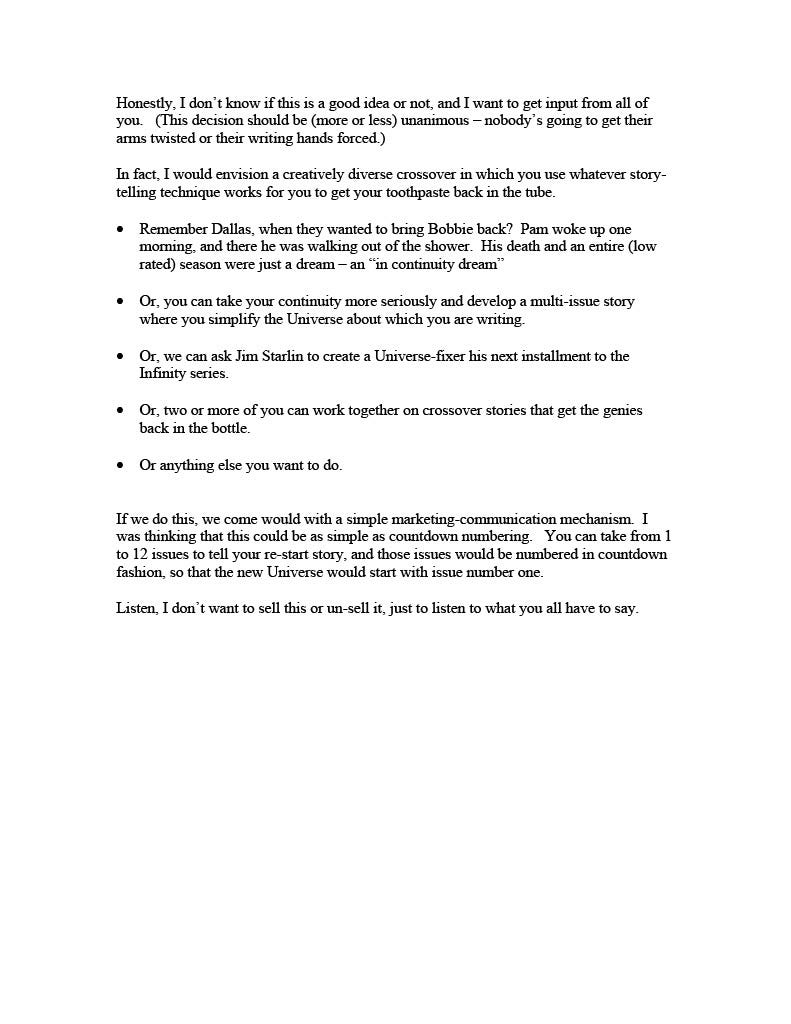
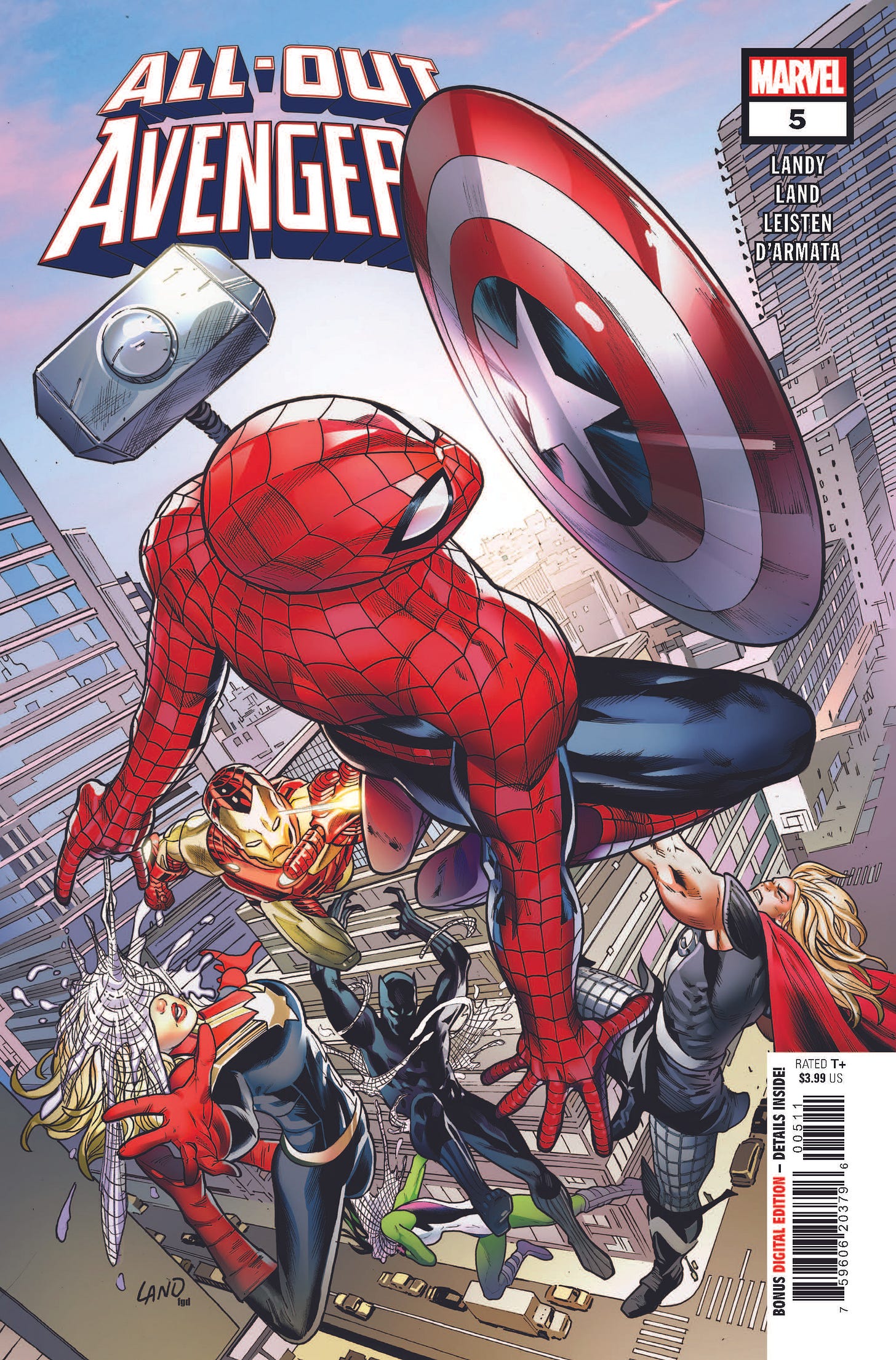
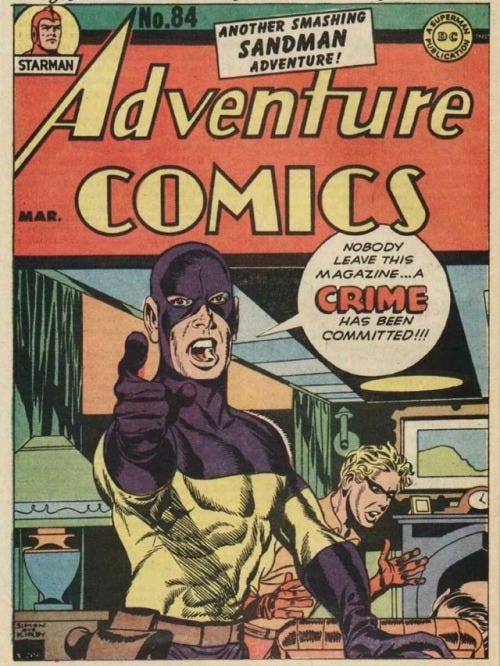
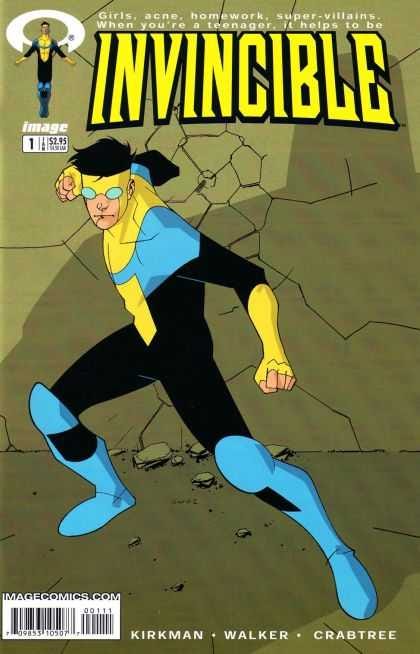
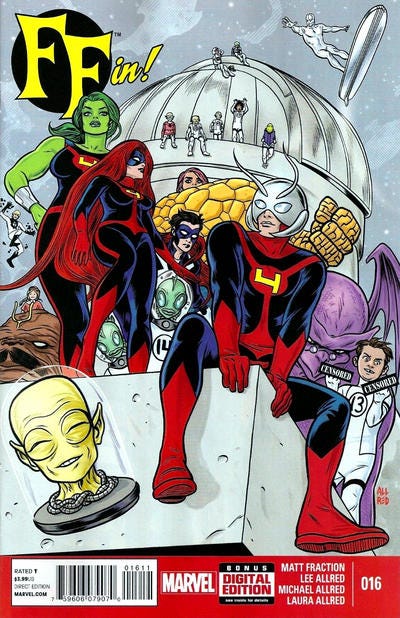

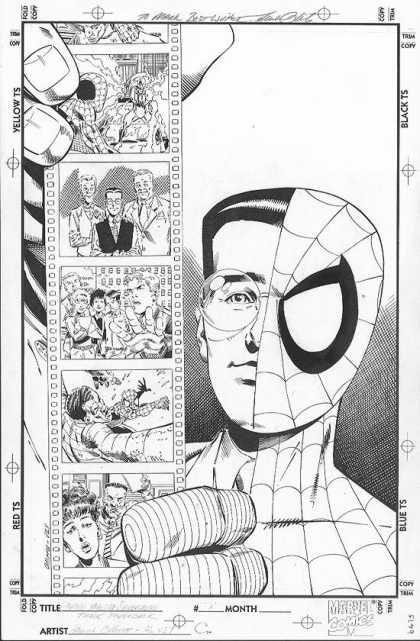
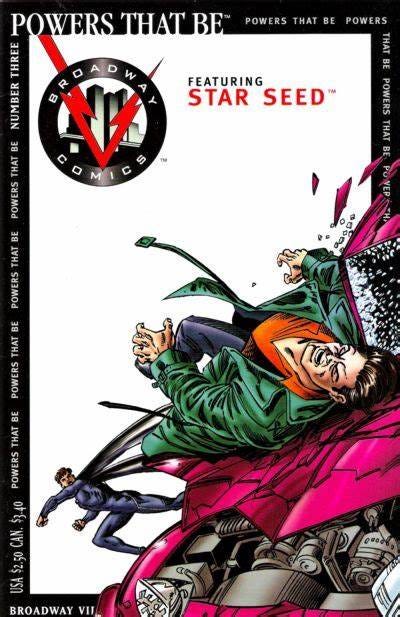
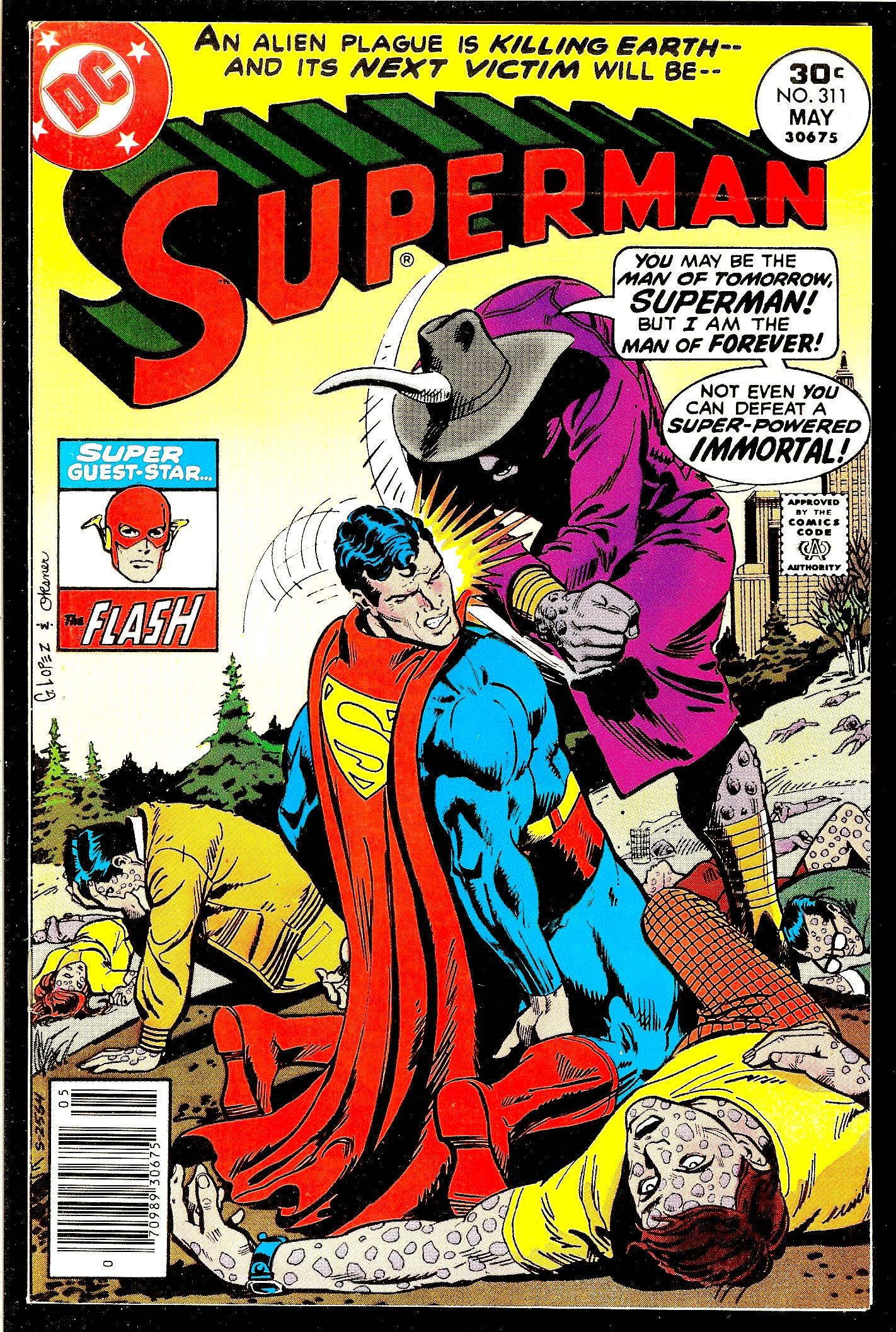
Around the time of the "Ultimate V. Traditional" discussions, I was a freelance illustrator who got a gig doing Marvel licensed work for a gaming company. Very exciting! Marvel gave us a document of character art to work from and I was surprised that most of it had the Ultimate versions of the characters. I thought I had a HUGE scoop that the Ultimate line was going to take the place of the main one!
My main memory of that job was that I did a cool drawing of Wolverine leaping, one leg in front, one behind, and the gaming people really didn't understand why one leg was smaller than the other, so they made me bring both legs to the front so it looked like Wolverine was pooping
I had never even heard of Comet Man until I was going through all the research for a cover. I put him in there, so I suppose I'll bear some small responsibility if a Comet Man renaissance spontaneously erupts.